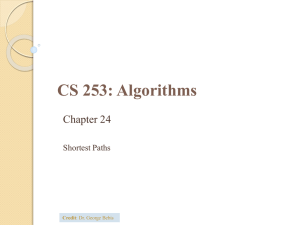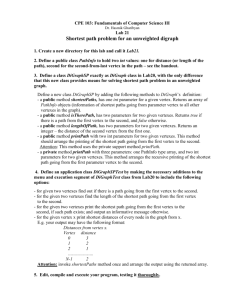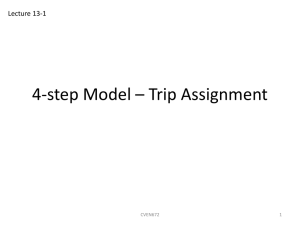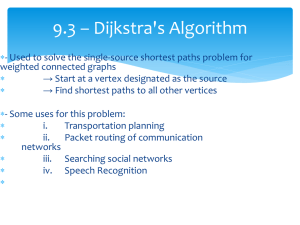a routing technique algorithm for vehicle navigation
advertisement
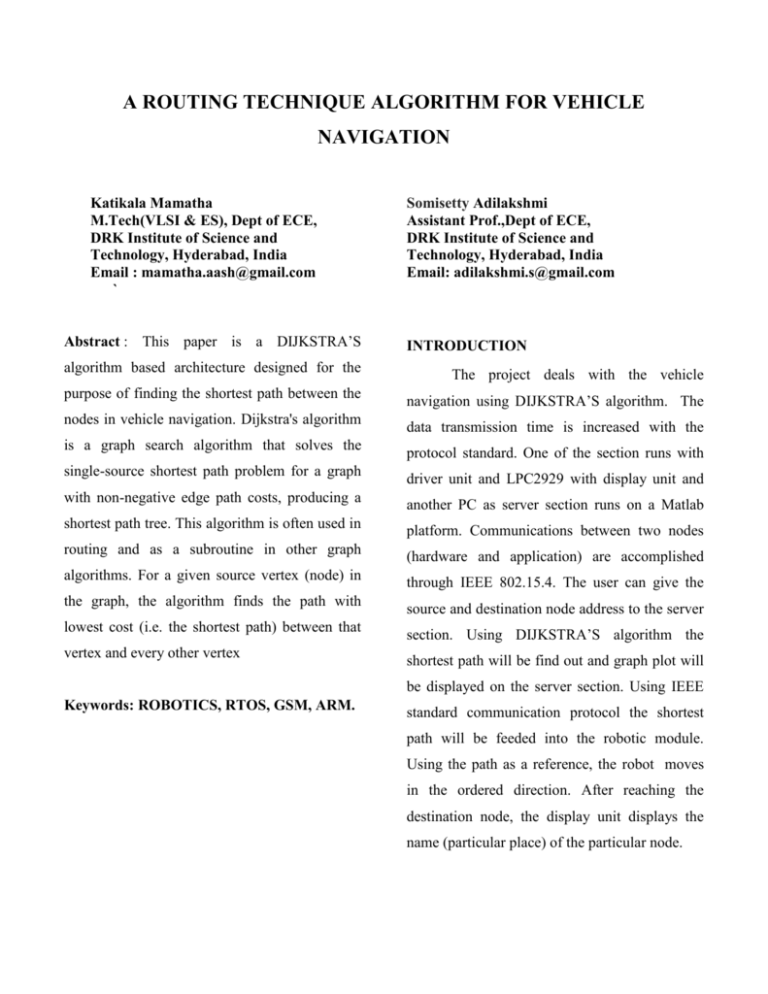
A ROUTING TECHNIQUE ALGORITHM FOR VEHICLE
NAVIGATION
Katikala Mamatha
M.Tech(VLSI & ES), Dept of ECE,
DRK Institute of Science and
Technology, Hyderabad, India
Email : mamatha.aash@gmail.com
`
Abstract : This paper is a DIJKSTRA’S
Somisetty Adilakshmi
Assistant Prof.,Dept of ECE,
DRK Institute of Science and
Technology, Hyderabad, India
Email: adilakshmi.s@gmail.com
INTRODUCTION
algorithm based architecture designed for the
The project deals with the vehicle
purpose of finding the shortest path between the
navigation using DIJKSTRA’S algorithm. The
nodes in vehicle navigation. Dijkstra's algorithm
data transmission time is increased with the
is a graph search algorithm that solves the
protocol standard. One of the section runs with
single-source shortest path problem for a graph
driver unit and LPC2929 with display unit and
with non-negative edge path costs, producing a
another PC as server section runs on a Matlab
shortest path tree. This algorithm is often used in
platform. Communications between two nodes
routing and as a subroutine in other graph
(hardware and application) are accomplished
algorithms. For a given source vertex (node) in
through IEEE 802.15.4. The user can give the
the graph, the algorithm finds the path with
source and destination node address to the server
lowest cost (i.e. the shortest path) between that
section. Using DIJKSTRA’S algorithm the
vertex and every other vertex
shortest path will be find out and graph plot will
be displayed on the server section. Using IEEE
Keywords: ROBOTICS, RTOS, GSM, ARM.
standard communication protocol the shortest
path will be feeded into the robotic module.
Using the path as a reference, the robot moves
in the ordered direction. After reaching the
destination node, the display unit displays the
name (particular place) of the particular node.
BLOCK DIAGRAM:
Two DTL buses (a universal NXP interface)
for interfacing to the interrupt controller and
Robot section:
the Power, Clock and Reset Control cluster
(also
called
subsystem).
Three
ARM
Peripheral Buses (APB - a compatible superset
ARM
Processor
Power
supply
U
A
R
of ARM's AMBA advanced peripheral bus) for
IEEE
802.15.4
Protocol
T
connection to on-chip peripherals clustered in
subsystems. One ARM Peripheral Bus for
event router and system control.
GPIO
The
LPC2926/2927/2929
configures
the
ARM968E-S processor in little-endian byte
order. All peripherals run at their own clock
Driver
unit
Display
unit
Driver
unit
frequency to optimize the total system power
consumption. The AHB-to-APB bridge used in
Motor 2
Motor 1
the subsystems contains a write-ahead buffer
one transaction deep. This implies that when
the ARM968E-S issues a buffered write action
to a register located on the APB side of the
Monitoring section
bridge, it continues even though the actual
write
IEEE 802.15.4
Protocol
Serial data
Transfer unit
Pro
Pro
may
not
yet
have
taken
place.
Completion of a second write to the same
subsystem will not be executed until the first
write is finished. The ARM968E-S is a general
HARDWARE DESIGN
purpose 32-bit RISC processor, which offers
ARM core:
high
ARM9 core:
consumption. The ARM architecture is based
The
LPC2926/2927/2929
consists
of:
performance and very low power
An
on Reduced Instruction Set Computer (RISC)
ARM968E-S processor with real-time emulation
principles, and the instruction set and related
support An AMBA multi-layer Advanced High-
decode mechanism are much simpler than
performance Bus (AHB) for interfacing to the
those
on-chip memory controllers
Instruction
of
microprogrammed
Set
Computers
Complex
(CISC).
This
simplicity
results
instruction
16-bit controller using 16-bit registers. This is
throughput and impressive real-time interrupt
possible because THUMB code operates on the
response from a small and cost-effective
same 32-bit register set as ARM code. THUMB
controller core. Amongst the most compelling
code can provide up to 65 % of the code size of
features of the ARM968E-S are: Separate
ARM, and 160 % of the performance of an
directly connected instruction and data Tightly
equivalent ARM controller connected to a 16-bit
Coupled
Write
memory system. The ARM968E-S processor is
buffers for the AHB and TCM buses Pipeline
described in detail in the ARM968E-S data sheet
techniques are employed so that all parts of the
The LPC2926/2927/2929 includes a 256 kB, 512
processing and memory systems can operate
kB or 768 kB flash memory system. This
continuously. The ARM968E-S is based on the
memory can be used for both code and data
ARMv5TE five-stage pipeline architecture.
storage. Programming of the flash memory can
Typically, in a three-stage pipeline architecture,
be accomplished via the flash memory controller
while one instruction is being executed its
or the JTAG. The flash controller also supports a
successor is being decoded and a third
16
instruction is being fetched from memory. In
integrated on
the five-stage pipeline additional stages are
addition to
added for memory access and write-back
LPC2926/2927/2929 includes two static RAM
cycles.
also
memories: one of 32 kB and one of 16 kB. Both
employs a unique architectural strategy known
may be used for code and/or data storage. In
as THUMB, which makes it ideally suited to
addition, 8 kB SRAM for the ETB can be used
high-volume
memory
as static memory for code and data storage.
restrictions or to applications where code
However, DMA access to this memory region is
density is an issue. The key idea behind
not supported.
Memory
in
a
high
(TCM)interfaces
The ARM968E-S
applications
processor
with
kB,
byte-accessible on-chip
the
EEPROM
LPC2926/2927/2929.
the two
32
kB
TCMs
In
the
THUMB is that of a super-reduced instruction
set. Essentially, the ARM968E-S processor has
LCD DISPLAY UNIT:
two instruction sets:
LCD DISPLAY
Standard 32-bit ARMv5TE set 16-bit THUMB
Liquid crystal displays (LCDs) have
set The THUMB set's 16-bit instruction length
materials which combine the properties of both
allows it to approach twice the density of
liquids and crystals. Rather than having a
standard ARM code while retaining most of the
melting point, they have a temperature range
ARM's performance advantage over a traditional
within which the molecules are almost as mobile
as they would be in a liquid, but are grouped
DIJKSTRA’SALGORITHAM:
together in an ordered form similar to a crystal.
This algorithm finds the shortest path from a
An LCD consists of two glass panels, with the
source vertex to all other vertices in a weighted
liquid crystal material sand witched in between
directed graph without negative edge weights.
them. The inner surface of the glass plates are
Here is the algorithm for a graph G with vertices
coated with transparent electrodes which define
V = {v1, ... vn} and edge weights wij for an edge
the character, symbols or patterns to be
connecting vertex vi with vertex vj. Let the
displayed polymeric layers are present in
source be v1.Initialize a set S = . This set will
between the electrodes and the liquid crystal,
keep track of all vertices that we have already
which makes the liquid crystal molecules to
computed the shortest distance to from the
maintain a defined orientation angle. One each
source.Initialize an array D of estimates of
polarisers are pasted outside the two glass
shortest distances. D[1] = 0, while D[i] = , for
panels. These polarisers would rotate the light
all other i. (This says that our estimate from v1 to
rays passing through them to a definite angle, in
v1 is 0, and all of our other estimates from v1 are
a particular direction. When the LCD is in the
infinity.)Essentially, what the algorithm is doing
off state, light rays are rotated by the two
is this:Imagine that you want to figure out the
polarisers and the liquid crystal, such that the
shortest route from the source to all other
light rays come out of the LCD without any
vertices. Since there are no negative edge
orientation,
appears
weights, we know that the shortest edge from the
transparent. When sufficient voltage is applied to
source to another vertex must be a shortest path.
the electrodes, the liquid crystal molecules
(Any other path to the same vertex must go
would be aligned in a specific direction. The
through another, but that edge would be more
light rays passing through the LCD would be
costly than the original edge based on how it was
rotated by the polarisers, which would result in
chosen.) Now, for each iteration, we try to see if
activating / highlighting the desired characters.
going through that new vertex can improve our
The LCD’s are lightweight with only a few
distance estimates. We know that all shortest
millimeters thickness. Since the LCD’s consume
paths contain subpaths that are also shortest
less power, they are compatible with low power
paths. (Try to convince yourself of this.) Thus, if
electronic circuits, and can be powered for long
a path is to be a shortest path, it must build off
durations.
another shortest path. That's essentially what we
and
hence
the
LCD
are doing through each iteration, is building
another shortest path. When we add in a vertex,
we know the cost of the path from the source to
stepping
motors,
as
well
as
other
high
that vertex. Adding that to an edge from that
current/high-voltage loads in positive-supply
vertex to another, we get a new estimate for the
applications. All inputs are TTL compatible.
weight of a path from the source to the new
Each output is a complete totem-pole drive
vertex.
This algorithm is greedy because we
circuit, with a Darlington transistor sink and a
assume we have a shortest distance to a vertex
pseudo-Darlington source. Drivers are enabled in
before we ever examine all the edges that even
pairs, with drivers 1 and 2 enabled by 1,2EN and
lead into that vertex. In general, this works
drivers 3 and 4 enabled by 3,4EN. When an
because we assume no negative edge weights.
enable input is high, the associated drivers are
The formal proof is a bit drawn out, but the
enabled and their outputs are active and in phase
intuition behind it is as follows: If the shortest
with their inputs. When the enable input is low,
edge from the source to any vertex is weight w,
those drivers are disabled and their outputs are
then any other path to that vertex must go
off and in the high-impedance state. With the
somewhere else, incurring a cost greater than w.
proper data inputs, each pair of drivers forms a
But, from that point, there's no way to get a path
full-H (or bridge) reversible drive suitable for
from that point with a smaller cost, because any
solenoid or motor applications. On the L293,
edges added to the path must be non-negative.By
external high-speed output clamp diodes should
the end, we will have determined all the shortest
be used for inductive transient suppression.
paths, since we have added a new vertex into our
set for each iteration.This algorithm is easiest to
CONCLUSION
follow in a tabular format. The adjacency matrix
of an example graph is included below. Let a be
The user can give the source and destination
the source vertex
node address to the server section. Using
L293D:
DIJKSTRA’S algorithm the shortest path will be
The L293 and L293D are quadruple high-current
find out and graph plot will be displayed on the
half-H drivers. The L293 is designed to provide
server
bidirectional drive currents of up to 1 A at
communication protocol the shortest path will be
voltages from 4.5 V to 36 V. The L293D is
feeded into the robotic module. Using the path as
designed to provide bidirectional drive currents
a reference, the robot
of up to 600-mA at voltages from 4.5 V to 36 V.
direction. After reaching the destination node,
Both devices are designed to drive inductive
the display unit displays the name (particular
loads such as relays, solenoids, dc and bipolar
place) of the particular node
section.
Using
IEEE
standard
moves in the ordered
REFERENCES:
[1] National Highway Traffic Safety Administration,”
Automotive Collision Avoidance Systems (ACAS) Final
Report”. August 2000.
[2] “Google Cars drive themselves in Traffic”, J. Markoff - The
New York Times, 2010 - bngumassd.org
[3] Tyler Folsom, “Social Ramifications of Autonomous Urban
Land Vehicles” IEEE International Symposium on Technology
and Society, May 2011, Chicago
[4] “A Method for Shortest Path Search using Extended
Dijkstra’s Algorithm”, IEEE International Conference on
System, Man and Cybernetics, 2000
[5] “Proof of a modified Dijkstra's algorithm for computing
shortest bundle delay in networks with deterministically timevarying links”, Lee, Fraser.S, IEEE Xplore 2011
[6] T.Imielinski and J.C. Navas, “GPS-Based Geographic
Addressing, Routing, and Resource Discovery,” Commun. ACM,
vol. 42, no. 4 Apr. 1999
[7]Q.Xu, R.Sengupta and D.Jiang, “Design and Analysis of
Highway Safety Communication Protocol in 5.9Ghz DSRC,”
Proc. IEEE VTC vol.57, no.4, 2003, pp. 2451-2455
AUTHOR BIOGRAPHY
S. Adilakshmi
She received her M.Tech from TKR College of
engineering
and
technology,
JNTUH,
Hyderabad. Currently she is a Asst. Professor at
DRK Institute Of Science & Technology,
JNTUH University, Hyderabad.
Dr. K Praveen Kumar received the Ph.D in
Microwave Antennas with EBG. Currently he is
a HOD at DRK Institute Of Science &
Technology, JNTUH University, Hyderabad.
Dr. Balasowrya received the Ph.D and currently
he is a Principal at DRK Institute of Science &
Technology, JNTUH University, Hyderabad.
Katikala Mamatha
Completed her U.G in Electronics and
Communication Engineering from JNTU,
Hyderabad, she is pursuing her Masters from
DRK Institute Of Science & Technology, with
specialization in VLSI&ES, JNTUH University,
Hyderabad.

